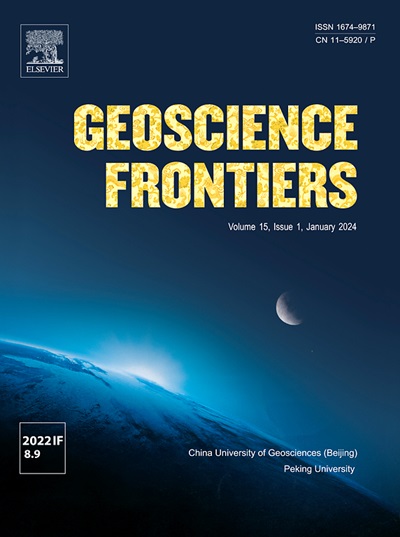Petrogenesis and tectonic implications of peridotites of the Shangla Complex Ophiolite along Main Mantle Thrust, Northern Pakistan
IF 8.9
1区 地球科学
Q1 GEOSCIENCES, MULTIDISCIPLINARY
引用次数: 0
Abstract
The Shangla Complex ophiolite represents a relic of the Neo-Tethyan oceanic lithosphere along the Indus Suture Zone (also known as the Main Mantle Thrust) in northern Pakistan. This section, thrust onto the continental margin between the Indian and Karakoram (Asian) plates, is predominantly composed of depleted harzburgites, dunites and chromitites. In this study, we conducted a thorough analysis of mineralogy, whole-rock geochemistry (major oxides, trace elements, PGE), and integrated Re-Os isotopic data from mantle-derived peridotites to understand their petrogenesis and melt evolution. These peridotites exhibit a depleted nature, characterized by a low modal composition of clinopyroxene, a wide forsterite content range in olivine (86.5 to 95.2), and a large variation in Cr# values (25.1–91.4). Their diverse whole-rock geochemistry further suggests varying degrees of partial melting. The Cpx-harzburgites show high average Al2O3 (1.83 wt.%), CaO (2.27 wt.%), ΣREE (12.9 ppb), and 187Os/188Os values between 0.13095 and 0.12571. On the other hand, the depleted harzburgites and dunites exhibit lower average Al2O3 (0.57 wt.% and 0.14 wt.%, respectively), CaO concentration (0.59 wt.% and 0.21 wt.%, respectively), and ∑REE concentrations, measured at 12.7 ppb and 8.9 ppb, respectively. The 187Os/188Os ratios in the depleted harzburgites and dunites range from 0.12643 to 0.11777, indicating they are less radiogenic compared to the Cpx-harzburgites. The spoon-shaped rare earth elements (REE) patterns suggest that the Cpx-harzburgites underwent low degrees of partial melting (∼10%–15%), whereas the depleted harzburgites and dunites indicate somewhat higher degrees of partial melting (additional melting of the Cpx-harzburgites). The PGE abundances in these depleted harzburgites and dunites are linked to the partial melting of Cpx-harzburgites, resulting in a boninitic-like melt. Their low degree of melting and melt extraction suggests that Cpx-harzburgites initially formed at a mid-ocean ridge (MOR) spreading center or a distal fore-arc basin. In contrast, the depleted harzburgites and dunites were formed during a second phase of melting, followed by refertilization, closely associated with a supra-subduction zone (SSZ) setting. The Re-Os isotopic systematics of the Shangla Complex peridotites reveal model age clusters of ca. 250 Ma and ca. 450 Ma, potentially corresponding to significant tectonic events in the geodynamic evolution of the Neo-Tethyan, Rheic, and Proto- Tethyan oceans.

巴基斯坦北部地幔主逆冲尚拉杂岩蛇绿岩橄榄岩成因及构造意义
尚拉杂岩蛇绿岩是巴基斯坦北部沿印度河缝合带(也称为主地幔逆冲带)的新特提斯海洋岩石圈的遗迹。该板块位于印度板块和喀喇昆仑(亚洲)板块之间的大陆边缘,主要由枯竭的哈尔茨伯尔岩、泥质岩和铬铁矿组成。在本研究中,我们对幔源橄榄岩的矿物学、全岩地球化学(主要氧化物、微量元素、PGE)和Re-Os同位素数据进行了全面分析,以了解其岩石成因和熔融演化。这些橄榄岩表现出贫化性质,其特点是斜辉石的模态组成低,橄榄石中的橄榄石含量范围宽(86.5 ~ 95.2),Cr#值变化大(25.1 ~ 91.4)。它们不同的全岩地球化学进一步表明了不同程度的部分熔融。Cpx-harzburgites表现出较高的Al2O3 (1.83 wt.%)、CaO (2.27 wt.%)、ΣREE (12.9 ppb)和187Os/188Os值(0.13095 ~ 0.12571)。另一方面,赤铁矿和泥质岩表现出较低的平均Al2O3(分别为0.57 wt.%和0.14 wt.%)、CaO浓度(分别为0.59 wt.%和0.21 wt.%)和∑REE浓度(分别为12.7 ppb和8.9 ppb)。贫哈尔茨伯尔岩和泥质岩的187Os/188Os比值在0.12643 ~ 0.11777之间,与cpx -哈尔茨伯尔岩相比,其放射性成因较小。勺状稀土元素(REE)模式表明Cpx-harzburgites经历了较低程度的部分熔融(~ 10%-15%),而耗尽的harzburgites和dunites则表明部分熔融程度较高(Cpx-harzburgites的额外熔融)。贫哈尔茨伯基岩和泥质岩中的PGE丰度与cpx -哈尔茨伯基岩的部分熔融有关,导致了类似博宁质的熔融。其较低的熔融程度和熔体提取表明,Cpx-harzburgites最初形成于洋中脊扩张中心或远弧前盆地。贫化的哈尔茨伯基岩和泥质岩则形成于熔融后的第二阶段,与超俯冲带(SSZ)环境密切相关。尚拉杂岩的Re-Os同位素系统揭示了约250 Ma和约450 Ma的模式年龄群,可能对应于新特提斯、Rheic和原特提斯海洋地球动力学演化中的重要构造事件。
本文章由计算机程序翻译,如有差异,请以英文原文为准。
求助全文
约1分钟内获得全文
求助全文
来源期刊

Geoscience frontiers
Earth and Planetary Sciences-General Earth and Planetary Sciences
CiteScore
17.80
自引率
3.40%
发文量
147
审稿时长
35 days
期刊介绍:
Geoscience Frontiers (GSF) is the Journal of China University of Geosciences (Beijing) and Peking University. It publishes peer-reviewed research articles and reviews in interdisciplinary fields of Earth and Planetary Sciences. GSF covers various research areas including petrology and geochemistry, lithospheric architecture and mantle dynamics, global tectonics, economic geology and fuel exploration, geophysics, stratigraphy and paleontology, environmental and engineering geology, astrogeology, and the nexus of resources-energy-emissions-climate under Sustainable Development Goals. The journal aims to bridge innovative, provocative, and challenging concepts and models in these fields, providing insights on correlations and evolution.
 求助内容:
求助内容: 应助结果提醒方式:
应助结果提醒方式:


